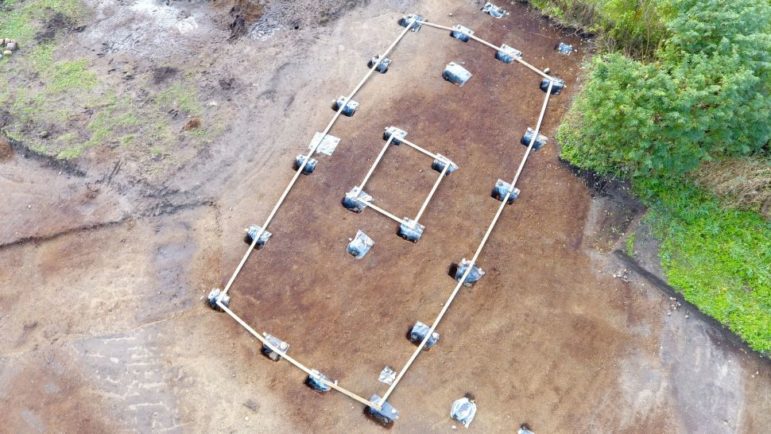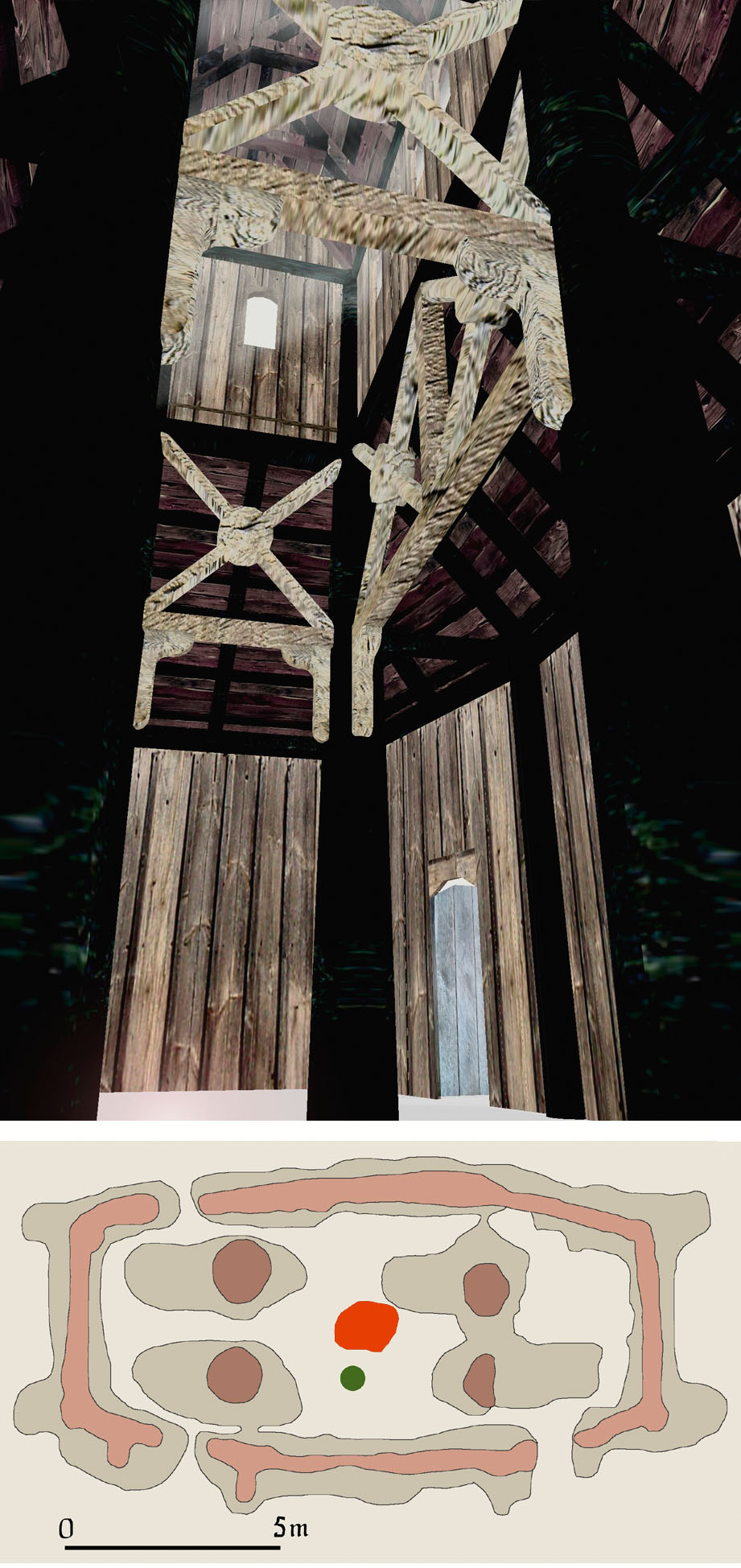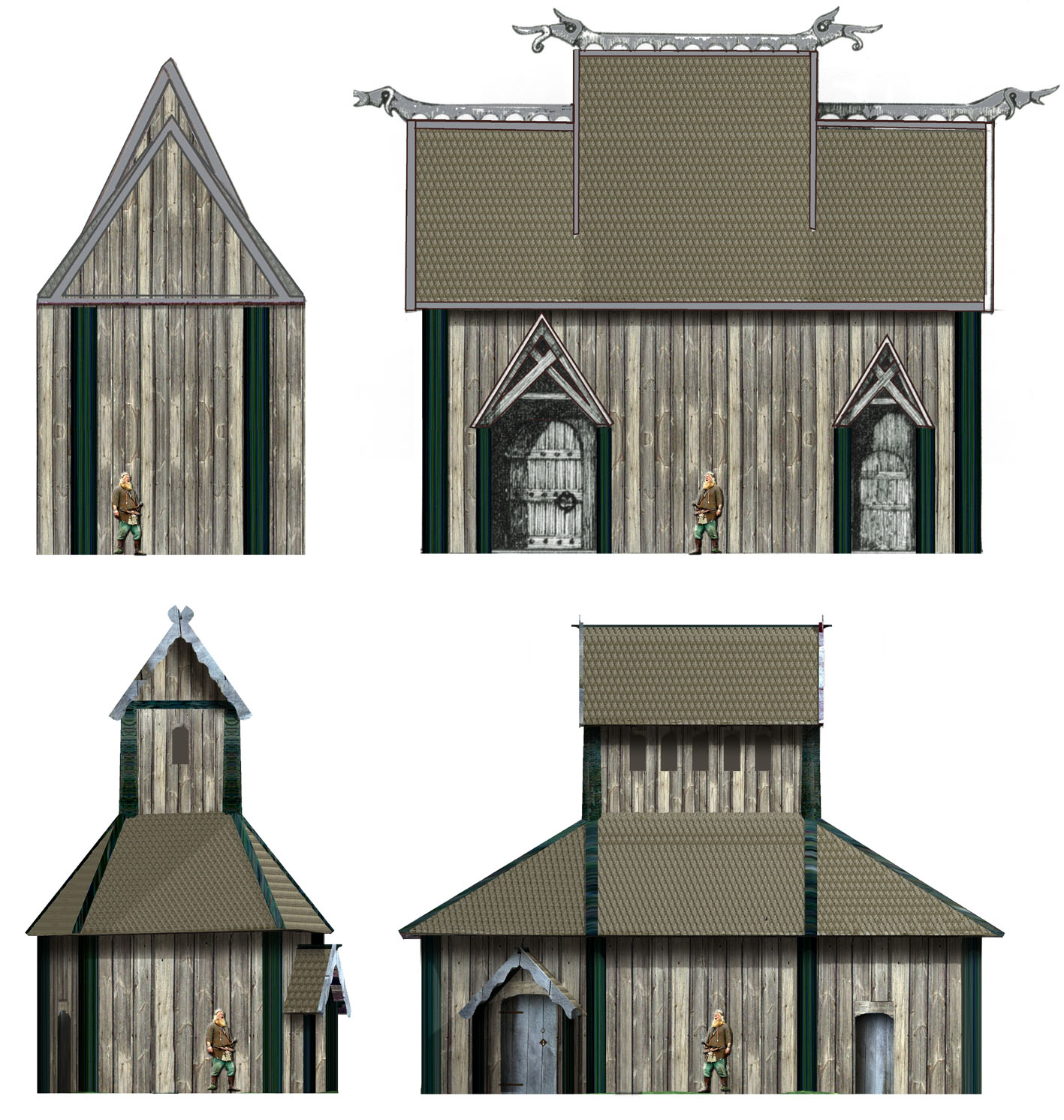TWH – In October 2020, LiveScience reported that Norwegian archaeologists found the first Viking Age god-house in that country.
Archaeologists from the University Museum of Bergen dated these remains to the late 700s C.E. According to Søren Diinhoff of that Museum, no one had found a god-house in Norway before.

The site sits roughly miles southwest of Trondheim, surrounded by mountains and near an inlet where the boathouses would have offered access to waterways. Image credit: University Museum of Bergen
This is not, however, the first Pagan site that dates to a similar period. TWH briefly reported on an earlier find in 2011, at Ranheim in Sør-Trøndelag, approx. 10 kilometers north of Trondheim. And it was reported in an article Aftenposten that detailed the 2011 unveiling of the site, which has many similar features as the site near Ørsta. Sadly, the site was at Ranheim in Sør-Trøndelag was excavated and then the area was cleared for the development of residences and businesses.
Other god-houses have also been found in Sweden and Denmark. In these god-houses, the Viking Norse left offerings and sacrificed animals. They found this structure in the seaside village of Øse, near Ørsta in western Norway.
Similar to the finds at Ranheim in Sør-Trøndelag, archaeologists found evidence for human activity at the Øse site dating to 400 B.C.E. Remains of two longhouses date to that period. Each longhouse would have been the site of a family farm. The Viking Norse built this god-house roughly 1000 years later.
Over the years, the wooden god-house rotted away. The wood rotted and decayed, but evidence of the postholes remained. A posthole contains the base of a structural, anchoring post. These postholes describe the skeletal structure of a wooden building. At each of the four corners of the rectangle, a posthole stood. Four more postholes stood in the center of the god-house.
This pattern of postholes defines the category “god-house.” From these remains, people can estimate the shape and size of the god-house. The larger the posthole, the more weight it could bear. Archaeologists have theorized that the four interior posts supported a tower rising out from the roof.
The god-house had a length of 14 meters (45 feet), a width of 8 meters (26 feet), and a maximum height of 12 m (40 feet). The sides curved slightly outwards.

Aerial view of the “god-house” Image credit: University Museum of Bergen
Close by the god-house, archaeologists found the remains of cooking pits. They also found many animal bones. They considered these bones to indicate communal feasting and probable animal sacrifice. Nearby they also found a large phallus stone, possibly used in fertility rituals.
According to LiveScience, Diinhoff said that the sacrifices and feasting occurred on the solstices. He also said that the Viking Norse made these sacrifices to Odin, Thor, and Freyr. People would have offered the gods, meat, drink, and sometimes gold. The gods partook in spirit, but the worshippers ate and drank the offerings.
In the 11th Century, the King of Norway imposed Christianity on his subjects. They closed down, burned, or built Christian churches on top of former Viking Norse Temples. At present, it is not clear if the god-house at Ose escaped that fate.
In order to understand the significance of this find, TWH spoke with a modern Norse Pagan, reviewed academic discussions of cultic practices of the Viking Norse, and examined studies of other god-houses.
A modern Norse Pagan perspective
Ryan Denison coordinator for PAPERS at Mystic South, and Heathen Men United, said that the practices described in the LiveScience article matched his general understanding of ancient Viking Norse practices. Denison pointed out, “There are a lot of changes after 536 C.E.”
After that date, cultural exchange with the Germanic and Byzantine cultures to the south began to influence the Norse.
According to Dennison, animal sacrifice “was accepted and readily used. There are many instances of animal sacrifice in the literary record we have.”
In other reporting about the find, animal sacrifices were noted. They reported, “During these rituals, according to experts, the blood of sacrificial animals was likely splashed over walls, statues of gods and party participants.”
Denison rejected any charge of possible sensationalism. He said, “That’s pretty accurate. The blood was seen as a blessing. In today’s blots, we still sling the dedicated mead on participants as a blessing. So definitely not sensationalized from what we know right now.”
Cultic practices of the Viking Age (750 to 1050 C.E.)
In “Religion, Brain & Behavior,” Raffield, Price, and Collard describe how academics have interpreted Viking Norse cultic offerings. They described three types of offerings. In a “Blot,” the Viking Norse would sacrifice an animal. On occasion, they may have sacrificed other humans. Another type of offering involved “burying” inanimate objects as offerings. The third type of offering involved placing objects in foundations and boundaries. Foundation offerings would occur in the construction of a building or in its abandonment.
Raffield, Price, and Collard also discussed how secular factors affected Viking Norse religious practices. Historians label the period from 375 to 750 C.E. “the Migration Period.”
Famines, natural disasters, the Plague of Justinian, mass tribal migrations, and constant warfare defined that era. Volcanic eruptions produced volcanic winters that lasted for years. Those volcanic winters caused crops to fail over many years. It destabilized Europe, western Asia, and North Africa. During this period, the Western Roman Empire collapsed. It brought the ancient world to an end.
In Scandinavia, society restructured during this period. Warrior elites formed petty warrior kingdoms. Those kingdoms now dominated Scandinavia. These warrior elites formed the base of the Odin cult. Inequality increased. By the end of the Viking period, centralized kingdoms developed. Those kingdoms imposed Christianity on the populace.
The god-house at Uppåkra in southern Sweden
Archaeologists only found the Norwegian god-house in the last few months. They have not yet had time to analyze their findings in depth. They have studied other god-houses more thoroughly. The god-house in Uppakra in southern Sweden has many similarities with this new find. Lars Larsson discussed that god-house in “The Iron Age ritual building at Uppakra, southern Sweden in “Antiquity.” Like the god-house at Ose, it had four internal postholes in the center of the building. In the center of those pillars, it had a fire pit. Over its lifetime, this god-house had a central fire pit most of the time. It sometimes had two.
People had occupied that 40 ha (0.14 square miles) site from the pre-Roman Iron Age through the Viking age. The god-house at Uppakra had a length of 13.5 m (44.3 ft) and a width of 6 m (19.7 ft.). It had slightly convex walls. The larger corner postholes indicated support for high walls and a roof. People entered through three entrances, with two on the southside and one on the north side.
The Viking Norse had buried artifacts under the floor, probably as offerings. They had buried two artfully crafted objects under the floor of the god-house. The Norse had buried a gold banded, bronze, and silver beaker. They also buried a cobalt blue glass bowl under the floor. The beaker and bowl dated from around 500 C.E.
Probably as foundation offerings, the Viking Norse also buried gold foil plaques in the wall trenches and post holes. Most depicted human males, some females. A few depicted male/female pairs. The Viking Norse buried many such artifacts in the northwest corner of the god-house. They had broken weapons to sacrifice them. They then buried those “dead” weapons north and south of the god-house.
Archaeologists dated the bones of sacrificed animals from 500 to 699 CE. To the west and north, four burial mounds lay. Overlooking a ledge, the god-house had a commanding view of the south.
Impact on modern Norse Pagans
Denison said that it is too soon to tell its impact on the modern revival of Norse Pagan practices. He said, “It depends on how the discovery pans out. We really don’t know a lot about it right now. But it could potentially be very influential. There are many groups in the U.S. looking to purchase land and have a hof, or house to the gods and a högr, or outdoor center of worship.”
The Wild Hunt is not responsible for links to external content.
To join a conversation on this post:
Visit our The Wild Hunt subreddit! Point your favorite browser to https://www.reddit.com/r/The_Wild_Hunt_News/, then click “JOIN”. Make sure to click the bell, too, to be notified of new articles posted to our subreddit.



